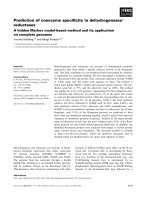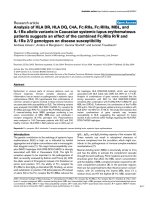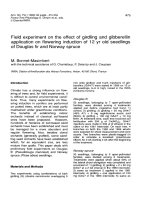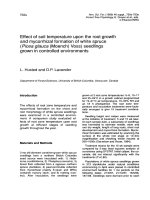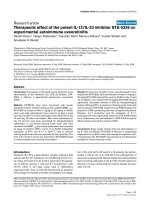Effect of soil test crop response based manure and fertilizer application on potassium fractions in soil inceptisol
Bạn đang xem bản rút gọn của tài liệu. Xem và tải ngay bản đầy đủ của tài liệu tại đây (269.79 KB, 8 trang )
Int.J.Curr.Microbiol.App.Sci (2020) 9(8): 1971-1978
International Journal of Current Microbiology and Applied Sciences
ISSN: 2319-7706 Volume 9 Number 8 (2020)
Journal homepage:
Original Research Article
/>
Effect of Soil Test Crop Response based Manure and Fertilizer Application
on Potassium Fractions in Soil Inceptisol
V. R. Mageshen*, R. Jayaraghavi, V.S.V.G. Naresh and N. Sathiya Bama
Department of Soil Science and Agricultural Chemistry, Pandit Jawaharal Nehru College of
Agriculture and Research Institute, Karaikal, Puducherry, India
*Corresponding author
ABSTRACT
Keywords
Incubation, STCRIPNS, Potassium
fractions, FYM,
Lower, Integrated
Article Info
Accepted:
18 July 2020
Available Online:
10 August 2020
An incubation experiment was conducted to study the combined effect of various
fertilizer doses and Soil Test Crop Response (STCR) based Integrated Plant
Nutrient System (IPNS) on potassium (K) fractions in bahour soil series of
puducherry. The incubation experiment was carried out with ten treatments and
three replications. The soil samples were drawn at 0th, 40th and 80th day of
incubation and subjected for analysis of Water Soluble K, Exchangeable K, and
Non Exchangeable K fractions. The results revealed that the application of STCR
+ IPNS – 180 q ha-1 treatment has improved the activities of Water Soluble K
(30.57 mg kg-1) and Exchangeable K (146.43 mg kg-1) and application of Farm
Yard Manure (12.5 t ha-1) alone increased the activity of Non exchangeable K
(381.50 mg kg-1). The simple regression analysis proved that the rate of release
was higher in STCR + IPNS treatments for water soluble and exchangeable K
whereas it was lower for non exchangeable K. Hence it can be concluded the
integrated use of STCR based NPK fertilizer along with IPNS increased the
available potassium fractions in soil.
Introduction
Potassium is one of the most important
primary nutrients which is required by plants
in large quantities and has several
physiological functions within the plant.
There are four forms of K in the soils:
solution K, exchangeable K, fixed K or non
exchangeable K and mineral K. The kinetic
and equilibrium reactions between the four
forms of soil K affect the level of K in soil
solution and readily available forms for plant
uptake at any particular time. The four forms
of K in the order of their availability to
microbes and plants are solution >
exchangeable > fixed > mineral K (Sparks
and Huang, 1985; Sparks, 1987; Sparks
2000). As regards the distribution of K in
1971
Int.J.Curr.Microbiol.App.Sci (2020) 9(8): 1971-1978
different
forms,
the
solution
and
exchangeable K are easily available for crop
uptake and non exchangeable K is relatively
less available, but can be made available by
the processes which induce the release of K
from the specific sites of K fixation on the
clay complex.
Soil solution K or water soluble K is the form
readily available for microbial and plant
uptake. The levels of soil solution K generally
are low unless a recent application of a K
fertilizer has been made. Solution K levels are
affected by equilibrium and kinetic reactions
that occur between the forms of soil K, soil
moisture content, concentrations of divalent
cations in solution and exchange phase
(Sparks, 2000). The exchangeable K is readily
available to plants, exchangeable with other
cations present in clay minerals and humic
substances. These adsorption sites can be
planes or edge position of clay minerals or the
negative charges created by carboxylic and
phenolic groups of humus colloids compared
to pH dependent negative charges on clay
(Kirkman et al., 1994). Exchangeable K is
held by the negative charges of organic matter
and clay minerals. Potassium in wedge, edge,
cracks and step positions is regarded as fixed
K. The amount of fixation depends on the
quantity and type of clay, and removal of K
from minerals.
The amount of each K fraction varies,
depending on cropping history, as well as
chemical fertilizer or organic manure
application. In some soils, non-exchangeable
K becomes available as the exchangeable and
solution K are removed by cropping or lost by
leaching. In other soils, release from nonexchangeable K is slow to meet crop
requirement. When there is surplus K in the
soil solution (by the addition of fertilizer), the
element is transferred to the exchangeable and
non-exchangeable fractions through exchange
and fixation process (Akinrinde, 2006). .
Potassium being a mobile element in plants,
behaves differently in soil and rarely a
dynamic equilibrium is observed in soil.
There is also very little information is
available on the K management involving
organic and inorganic sources. Keeping all
these things in mind, present study was
emphasised on potassium fractions under
controlled conditions.
Materials and Methods
Laboratory experiment
The incubation experiment was conducted at
Pandit Jawaharlal Nehru College of
Agriculture
and
Research
Institute,
PAJANCOA & RI, Karaikal in 2018 .
The
study was taken up on a inceptisol soil
belongs to Bahour soil series, classified as
fine, mixed isohyperthermic, Typic Ustropept.
The treatments allocated were T1-Control, T2 FYM t ha-1,T3- blanket
recommendation, T4 - farmer’s practice , T5STCR-NPK alone @ 160 q ha-1 yield target,
T6 - STCR-NPK alone @ 170 q ha-1 yield
target, T7 - STCR-NPK alone @ 180 q ha-1
yield target, T8 STCR-IPNS @ 160 q ha-1
yield target, T9 – STCR-IPNS @ 170 q ha-1
yield target,T10 – STCR- IPNS @ 180 q ha-1
yield target. The treatments were replicated
three times in complete randomized design
(CRD). The soil used for incubation was
neutral in pH and low in salt content. The soil
was low in organic carbon. The available N,P
and K status were low, medium and medium
respectively.
Soil sample collection
Soil samples collected were air-dried and
sieved through a 2-mm sieve. A sample of
500 g of soil was weighed into plastic cups
with tight lids. The soil was thoroughly mixed
with different rates of organic and inorganic
fertilizers and brought to field capacity with
1972
Int.J.Curr.Microbiol.App.Sci (2020) 9(8): 1971-1978
deionized water. The plastic cups were left in
the laboratory at room temperature (25 °C).
To enhance the rate of decomposition, the soil
was stirred once daily with a glass rod and left
opened for 2 h to allow the release of CO2 as
to reduce CO2 stress on microbial activities.
The soil samples were drawn at 0, 40 and 80
days of incubation, processes and subjected to
potassium fractionation viz., Water soluble K
(Narayanan Nambiar, 1972), Exchangeable K
(Pratt, 1965) and Non Exchangeable K (Wood
and De turk, 1940).
Potassium fractionation
Water soluble potassium
Ten gram of soil sample was transferred to a
centrifuge tube and 25 ml of distilled water
was added. The tube was shaken for 10
minutes, centrifuged and the clear supernatant
liquid was filtered. The filtrate was collected
in 100 ml volumetric flask. Three additional
extractions were made in the same manner
and the combined extract diluted to 100 ml
with distilled water. The extract thus obtained
was mixed well and potassium determined by
using flame photometer (Narayanan Nambiar,
1972).
Non exchangeable potassium
Normal nitric acid (HNO3) extractable
potassium was determined by employing the
method of Wood and De Turk (1940). A 2.5 g
finely ground soil sample was transferred to a
100 ml conical flack and 25 ml of normal
nitric acid was added. The flask was then
heated over a gas burner and the content was
made to boil gently for 10 minutes. The
content was then cooled, diluted, filtered and
the filtrate was collected in a 100 ml
volumetric flask. The soil residue was then
washed four times with 15 ml portions of
0.1NHNO3 and collected in the same
volumetric flask, mixed thoroughly and K
determined using flame photometer. The
difference between the normal nitric acid
extractable K and water soluble plus
exchangeable K was taken as nonexchangeable K.
Statistical analysis
The data on potassium fractions were
subjected to statistical scrutiny following the
procedure outlined by Gomez and Gomez
(1976). A simple linear regression analysis
was performed to know release pattern of
potassium under different treatments.
Exchangeable potassium
Results and Discussion
The method of Pratt (1965) was followed. A
10 g of soil sample was transferred to a 50 ml
centrifuge tube and 25 ml of neutral normal
ammonium acetate was added to the tube. The
tube was shaken for 10 minutes, centrifuged
and the clear supernatant liquid filtered. The
filtrate was collected in a 100 ml volumetric
flask. Three additional extractions were made
in the same manner and the combined extracts
diluted to 100 ml with neutral normal
ammonium acetate. The solution was mixed
well and K estimated using flame photometer.
The difference between water soluble and the
ammonium acetate extractable K was
computed as the exchangeable K.
Water soluble-K
Data on the effects of organic and inorganic
source on water soluble K at different days of
incubation is presented in Table 1. The
highest water soluble K (30.57 mg kg-1) was
recorded in STCR+IPNS-180 q ha-1 treatment
followed by STCR+IPNS-170 q ha-1 (28.84
mg kg-1) which was comparable with STCRNPK alone and blanket recommendation
treatments. The lowest water soluble K (23.38
mg kg-1) was recorded in control. The highest
water soluble K was recorded at 80th day of
incubation followed by 40th day of incubation
1973
Int.J.Curr.Microbiol.App.Sci (2020) 9(8): 1971-1978
which were on par with each other. The
interaction effect between treatments and days
was significant and further revealed that the
highest amount of water soluble K was
noticed in STCR + IPNS – 180 q ha-1
treatment at 80th day of incubation. The
change in the water soluble K was found to be
- 0.023 mg kg-1 day-1 in control as compared
to 0.148 mg kg-1 day-1 in STCR+IPNS- 180 q
ha-1 Table 4. The rate of release of water
soluble K was found to be non significant in
STCR-NPK alone, farmer’s practice and
control treatments,
whereas it was
significantly predicted in STCR+IPNS-180 q
ha-1 treatment (R2= 0.928**) with a rate of
release of 0.148 mg kg-1 day-1
In the present investigation, the highest water
soluble K content was recorded in
STCR+IPNS treatments. Except in organic
manure added treatments all the other
treatments had registered higher water soluble
K upto 40th day of incubation thereafter it
decreased. This might be due to the fixation
of K on non exchangeable sites as there is an
increase in K+ ions in the solution.
The excess of K+ ions in solution get
exchanged with other cations and get fixed on
exchangeable and non exchangeable sites.
The increase in water soluble K in STCRIPNS treatment shows the release of K from
the added K and also from the organic and
native source and also due to the favourable
influence of FYM on soil properties. The
simple linear regression analysis revealed that
the water soluble K content of the soil was
significantly predicted in STCR-IPNS
treatment (R2 = 0.928**) further confirmed
the above result.
Exchangeable-K
The highest amount of exchangeable K
content was registered in STCR + IPNS – 180
q ha-1 treatment (146.43 mg kg-1) which was
significantly different from all the other
treatments Table 2. Among the treatments
FYM (12.5 t ha-1) alone treatment recorded
lowest amount (127.87 mg kg-1) of
exchangeable K content, and was comparable
with farmer’s practice (131.60 mg kg-1) .The
highest Exchangeable K content was recorded
at 80th day of incubation (138.81 mg kg-1)
which was significantly different from all the
other days but the 0th day and 40th day of
incubation were on par with each other. The
interaction effect further revealed that the
highest amount of exchangeable K was
noticed in STCR + IPNS – 180 q ha-1
treatment at 80th day of incubation followed
by other STCR + IPNS treatments. The
change in exchangeable K content was
quantified using simple regression analysis
Table 4. It was found to be significantly
explained in STCR + IPNS and blanket
recommendation treatments by the days of
incubation. It was noticed that in STCR +
IPNS– 180 q ha-1 treatment the rate of release
was 0.266 mg kg-1 day-1 as compared to 0.031
mg kg-1 day-1 in blanket recommendation. It
was also worth mentioning that the rate of
release was lower with the application of
STCR-NPK alone than when they were
applied with organics.
Application of organic manure along with
STCR and blanket recommendation had
registered higher exchangeable K content and
the release was increased upto 80th day of
incubation. This might be due to the fact that
the addition of FYM could increase the CEC
of the soil, which can hold more
exchangeable K and convert K from non
exchangeable K form to exchangeable K form
(Kirkman et al., 1994). The integrated use of
organic manures with the inorganic fertilizes
have resulted in an increase in the water
soluble and exchangeable K, it might be due
to the release of organic acids during
decomposition of organic manure, which
dissolves the K present in mineral form (or) in
the non exchangeable form (Swetha, 2015).
1974
Int.J.Curr.Microbiol.App.Sci (2020) 9(8): 1971-1978
Table.1 Effect of different fertilizer doses of NPK and STCR – IPNS on
Water Soluble- K (mg kg-1)
Treatments
T1-Control
T2- FYM (12.5 t ha-1) alone
T3-Farmer’s Practice
T4-Blanket Recommendation
T5-STCR-NPK alone-160 q ha-1
T6-STCR-NPK alone-170 q ha-1
T7-STCR-NPK alone-180 q ha-1
T8-STCR+IPNS-160 q ha-1
T9-STCR+IPNS-170 q ha-1
T10-STCR+IPNS-180 q ha-1
Days Mean
S.Ed
C.D(0.05)
0th day
40th day
80th day
24.20
25.26
27.03
26.04
25.20
25.32
25.44
24.75
24.44
24.97
25.26
23.62
19.32
22.06
23.62
28.62
30.62
32.22
26.12
28.62
29.88
26.47
22.32
26.20
24.62
28.10
21.62
22.56
23.86
29.52
33.46
36.86
26.91
T
1.70
3.40
D
0.90
1.90
Treatment
Mean
23.38
23.59
24.57
25.92
25.14
26.16
27.17
26.79
28.84
30.57
TXD
3.00
NS
Table.2 Effect of different fertilizer doses of NPK and STCR - IPNS on
Exchangeable- K(mg kg-1)
Treatments
T1-Control
T2- FYM (12.5 t ha-1) alone
T3-Farmer’s Practice
T4-Blanket Recommendation
T5-STCR-NPK alone-160 q ha-1
T6-STCR-NPK alone-170 q ha-1
T7-STCR-NPK alone-180 q ha-1
T8-STCR+IPNS-160 q ha-1
T9-STCR+IPNS-170 q ha-1
T10-STCR+IPNS-180 q ha-1
Days Mean
0th day
132.52
134.56
135.60
136.62
135.60
137.00
136.86
132.52
135.60
137.02
135.39
S.Ed
C.D(0.05)
40th day
131.60
120.62
128.60
132.20
139.42
144.60
148.80
135.60
140.32
143.96
136.57
T
0.62
1.25
D
0.34
0.68
1975
TXD
1.08
2.16
80th day
130.52
128.44
130.62
139.12
131.60
135.60
137.12
145.60
151.22
158.32
138.81
Treatment Mean
131.54
127.87
131.60
135.98
135.54
139.06
140.92
137.90
142.38
146.43
Int.J.Curr.Microbiol.App.Sci (2020) 9(8): 1971-1978
Table.3 Effect of different fertilizer doses of NPK and STCR - IPNS on
Non Exchangeable- K (mg kg-1)
Treatments
T1-Control
T2- FYM (12.5 t ha-1) alone
T3-Farmer’s Practice
T4-Blanket Recommendation
T5-STCR-NPK alone-160 q ha-1
T6-STCR-NPK alone-170 q ha-1
T7-STCR-NPK alone-180 q ha-1
T8-STCR+IPNS-160 q ha-1
T9-STCR+IPNS-170 q ha-1
T10-STCR+IPNS-180 q ha-1
Days Mean
0th day
367.60
360.78
360.09
361.70
359.82
364.56
360.36
363.51
364.94
358.67
362.20
S.Ed
C.D(0.05)
40th day
364.96
406.26
379.96
372.84
340.58
329.18
319.20
374.40
372.74
373.38
363.35
T
8.59
17.20
D
4.70
9.42
80th day
365.76
377.48
370.88
348.00
365.44
365.66
367.68
330.00
315.34
301.14
350.73
Treatment Mean
366.10
381.50
370.31
360.84
355.28
353.13
349.08
355.97
351.00
344.39
TXD
14.88
29.80
Table.4 Results of simple regression analysis between potassium fractions (Y) and days of
incubation (X)
Treatments
T1-Control
T2- FYM (12.5 t ha1
) alone
T3-Farmer’s
Practice
T4-Blanket
Recommendation
T5-STCR-NPK
alone-160 q ha-1
T6-STCR-NPK
alone-170 q ha-1
T7-STCR-NPK
alone-180 q ha-1
T8-STCR+IPNS-160
q ha-1
T9-STCR+IPNS-170
q ha-1
T10-STCR+IPNS180 q ha-1
Water soluble K
Exchangeable K
Intercept Changes
R2
Intercept Changes
per day
per day
(mg kg-1
(mg kg-1
day-1)
day-1)
0.385 NS 24.32
- 0.023 0.060 NS 132.54
- 0.025
0.614*
23.12
0.011
0.147 NS 130.93
- 0.076
Non Exchangeable K
R2
Intercept Changes
per day
(mg kg-1
day-1)
0.003NS
367.02
0.023
0.077 NS
373.15
0.208
0.188NS
25.77
- 0.030
0.216NS
134.09
- 0.062
0.065 NS
364.91
- 0.134
0.657*
24.89
0.025
0.554*
134.73
0.031
0.397*
367.69
- 0.371
0.265 NS
27.02
- 0.051
0.125 NS
137.54
- 0.050
0.016 NS
352.47
0.070
0.102 NS
27.54
- 0.034
0.011 NS
139.76
- 0.017
0.0004 NS
352.58
0.083
0.001 NS
26.90
- 0.004
0.0003
140.79
0.003
0.013 NS
345.42
0.091
R2
NS
0.725**
24.41
0.059
0.669**
131.36
0.163
0.429*
372.72
- 0.418
0.904**
24.33
0.112
0.739**
134.57
0.195
0.483*
375.69
- 0.500
0.928**
24.62
0.148
0.825**
135.78
0.266
0.472*
373.23
- 0.720
1976
Int.J.Curr.Microbiol.App.Sci (2020) 9(8): 1971-1978
Non exchangeable-K
The results indicated that the highest non
exchangeable K content was recorded in
FYM (12.5 t ha-1) alone treatment (381.50 mg
kg-1) followed by farmer’s practice (370.31
mg kg-1) and control treatments (366.10 mg
kg-1). At 40th day of incubation the highest
non exchangeable K content was observed
followed by 0th day of incubation which were
on par with each other Table 3. The
interaction effect further revealed that the
highest amount of non exchangeable K was
noticed in FYM (12.5 t ha-1) alone treatment
at 40th day of incubation and the lowest being
recorded in STCR + IPNS treatments. The
rate of decrease in non exchangeable K
content was quantified using simple
regression analysis which revealed that in
STCR+IPNS and blanket recommendation
treatments, the significant change in non
exchangeable K content could be attributed to
the number of days of incubation Table 4. The
rate of decrease was found to be maximum in
the case of STCR + IPNS – 180 q ha-1 (0.720 mg kg-1 day-1) and the least was in
control (0.023 mg kg-1 day-1). It was further
noticed that when organic manure was
applied along with STCR there was sharp
increase in the rate of decrease as compared
to STCR-NPK alone
in water soluble and exchangeable K in these
treatments. The greater depletion of non
exchangeable K in the presence of organic
matter might be due to the shift in CEC sites
towards divalent selectivity (Salmon, 1964)
which would decrease percentage K
saturation of CEC resulting in the shift of
equilibrium of non exchangeable K to
exchangeable K (Majumdar et al., 2002).
In conclusion, the application of STCR+IPNS
treatment increased the content of water
soluble K and exchangeable K fractions and
decrease the non exchangeable K content. The
organic acids released as a result of
decomposition of organic manures help in the
conversion of the non-exchangeable forms of
K to available forms of K. However, organic
manures alone cannot meet the nutrient
requirements as they contain small amounts
of essential nutrients and get released slowly
during
decomposition,
thus
nutrients
requirement of the crop when needed is not
fulfilled. Hence a blend of organic manures
and inorganic fertilizers ensures the
immediate supply of the nutrients from
inorganic fertilizers in the initial stages and
from the decomposition of organic manures to
cater to the nutrient needs at the later stages of
crop growth.
References
Application of organic manures increased the
non exchangeable K upto 40 DAI and
decreased at 80th day . The decrease in the
non-exchangeable K at 80th day in the
treatments receiving either the organic
manures or the STCR+IPNS practices could
be due to the formation of organo metallo
complexes of higher solubility. The
corresponding increase in easily available
forms of K appears to have resulted from their
translocation from non-exchangeable to easily
soluble forms. This could be clearly visible
with a significant decrease in the nonexchangeable K and a corresponding increase
Akinrinde, O. O. 2006. Strategies for
improving crop’s use- efficiencies of
fertilizer nutrients in sustainable
agricultural systems. Pakistan Journal of
Nutrition5 (2):185–93.
Gomez, A.A. and R.A. Gomez. 1976.
Statistical procedure for agricultural
research with emphasis on rice. IARI.
Los Banos, Manila, Philippines. pp.
294.
Kirkman, J.H., A. Baskar, A. Srapaneni, A.N.
Macgregor. 1994. Potassium in the soils
of New Zealand. New Zealand J. of
1977
Int.J.Curr.Microbiol.App.Sci (2020) 9(8): 1971-1978
Agric. Res. 37: 207-227.
Majumdar, B., M.S. Venkatesh, Kailash
Kumar and Patiram. 2002. Effect of
levels of potassium and FYM on yield
and uptake of nutrients by sweet potato
and different forms of K in an acidic
Alfisol of Meghalaya. J. Potash Res.,
18: 84-89.
Narayan Nambiar, P.K. 1972. Studies on soil
potassium. Ph.D., Thesis. Tamil Nadu
Agricultural University, Coimbatore,
India.
Pratt, P.E. 1965. Potassium. In Methods of
Soil Analysis. C.A. Black (ed). Part 2.
Agronomy 9, Amer. Soc. of Agron.,
Madison, Wis., pp. 1022 -1030.
Salmon. 1964. Cation exchange reactions. J.
Soil Sci, 15: 273-283.
Sparks, D.L. 1987. Potassium dynamics in
soils. Adv. Soil Sci. 6:1-63.
Sparks, D.L. 2000. Bioavailability of soil
potassium. In M.E. Sumner (ed.)
Handbook of soil science, CRC Press,
Boca Raton, FL. pp. 38-52
Sparks, D. L., and P.M. Huang. 1985.
Physical chemistry of soil potassium. In
Munson, R. D. (ed.). Potassium in
agriculture. SSSA, Madison, WI. pp.
201-276.
Swetha, L. 2015. Integrated nutrient
management in bhendi (Abelmoschus
esculentus L.) with special reference to
potassium. M.sc thesis. PJTSAU,
Hyderabad, India.
Wood, L.K. and E.E. De Turk. 1940.
Adsorption
of
ammonium
and
potassium in non- replaceable forms.
Pro. Soil Sci. Soc. Am., 5: 152 - 161.
How to cite this article:
Mageshen, V. R., R. Jayaraghavi, V.S.V.G. Naresh and Sathiya Bama, N. 2020. Effect of Soil
Test Crop Response based Manure and Fertilizer Application on Potassium Fractions in Soil
Inceptisol. Int.J.Curr.Microbiol.App.Sci. 9(08): 1971-1978.
doi: />
1978
